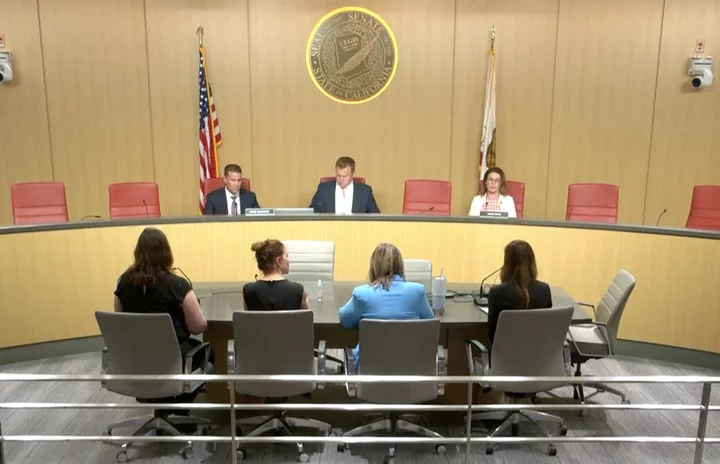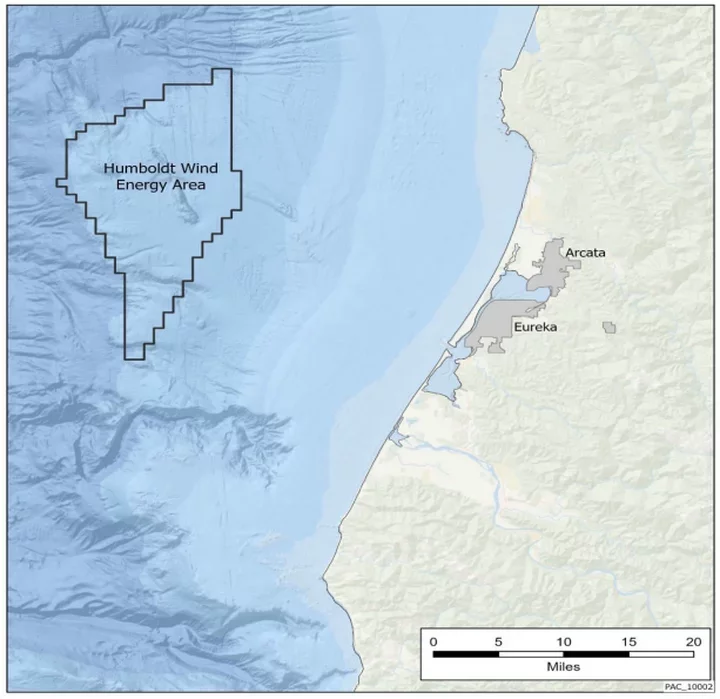Screenshot of Wednesday’s Joint Committee on Fisheries and Aquaculture hearing at the state capitol. Screenshot.
###
State Senate Majority Leader Mike McGuire, Chair of the Joint Committee on Fisheries and Aquaculture, held a hearing on Wednesday afternoon to discuss next steps with floating offshore wind development along the West Coast and to explore strategies to enhance coastal environmental protections while also protecting the interests of California’s fishing fleet.
“As we all know, the Golden State is staring down some extraordinary deadlines to meet our climate goals, and power generation plays a massive role in achieving these goals,” McGuire said during Wednesday’s hearing. “If we are serious about meeting these deadlines, we’re going to have to move heaven and earth to deploy new green power generation facilities in every corner of the Golden State.”
Late last year, the Bureau of Ocean Energy Management (BOEM) auctioned off five leases – two off Humboldt Bay and three off Morro Bay – totaling nearly 600 square miles for the development of floating offshore wind energy facilities. The lease auction was the first of its kind on the West Coast and a critical component in furthering the Biden-Harris administration’s goal of deploying 30 gigawatts (GW) of offshore wind energy by 2030 and 15 GW of floating offshore wind energy by 2035.
The future site of the floating offshore wind farm. Map: BOEM
BOEM finalized and executed the lease agreements just this week, but there’s still a long way to go – perhaps another ten years – before the floating turbines start spinning off of our shores.
“The very first thing that’s due [next] are the communication plans,” said Jen Miller, BOEM’s chief of the Renewable Energy Section for the Pacific Region. “We will have a communications plan for the fisheries, Native American tribes, [as well as federal and state] agencies. I would say the first thing to get right are those communications plans … making sure that they’re robust, they’re thoughtful, and that they consider all of the needs … of those groups that are resource-constrained. How do we make sure that that engagement is as regular as needed, but not overbearing?”
Yurok Tribal Vice-Chair Frankie Myers expressed his appreciation to federal and state representatives “for simply including tribes and making sure that we were heard and included in [this] conversation.”
“I think that’s absolutely the right first step that we have to take [while] looking at the potential for offshore wind here in California,” he said. “From my perspective – from the Yurok perspective – we view the world around us as a part of who we are, that we are a part of the world around us. … We look towards our past to help guide us into our future and I think it’s critically important that we continue that same methodology as we look at offshore wind.”
The communication plans are due in the next three months. Once those are complete, various agencies and environmental entities will begin a survey and data collection process to better inform the design and layout of the wind farms.
One of the biggest concerns that has cropped up around the development of offshore wind is its potential impact on marine ecosystems. Miller noted that BOEM’s environmental studies program has already done “quite a bit of work on marine mammals and entanglement studies for floating offshore wind,” but acknowledged that they “need to do more [research] that is specific to the West Coast.”
“One of the studies that has really received a lot of traction was the entanglement study that looks at potential entanglement risk due to potential floating cables that will connect wind turbines here in the Pacific [to the sea floor],” she continued. “That was identified as a potential risk. … And then we do have marine mammal mitigations that have been in place for our Atlantic leases [which] include a lot of passive acoustic monitoring for activities that are occurring on vessels and in the ocean.”
Garry George, director of the Clean Energy Initiative at the National Audubon Society, also underscored the importance of protecting birds.
“Just in terms of science, I want to remind you that Audubon’s 2019 study, [“Survival by Degrees: 389 Bird Species on the Brink”], reveals that if warming gets to 3º Celsius above pre-industrial levels, we may lose 389 species of North American birds. … We support rapid deployment to get to 100 percent clean energy as fast as possible. … In order to protect the California marine resources that are on and above the water – that would be birds and bats – the state of California needs to ensure that the siting and operation is informed by good collaborative independent science.”
Commercial fisheries are at risk as well. Mike Conroy, West Coast director for the Responsible Offshore Development Alliance, acknowledged that impacts to the industry are likely inevitable but said, “the scale of those impacts remains unknown.”
“Can offshore wind and fisheries coexist?” he asked, repeating the question posed on the agenda. “I appreciate the question as our coexistence is presumed. The fishing industry has some serious concerns. … We have been asking BOEM to slow down the process, build out the five lease areas and let them operate so we can actually see what the impacts will be. If offshore wind will wreak havoc on the form and function of California’s marine ecosystem, then we need to stop it.”
When “unavoidable” and “unmitigated” impacts are identified and better understood, “compensating impacted community members should be a priority,” Conroy added.
Speaking on behalf of the committee, McGuire emphasized the importance of a statewide approach rather than a port-by-port approach for lost fishing grounds.
“There is going to have to be some type of mandatory compensation for lost fishing ground,” he said. “We know that this climate crisis has impacted the fleet as we see a shorter Dungeness crab season … and they’re struggling. We’re going to need to be able to work with offshore wind to ensure that they’re gonna continue to thrive. … Same thing with California’s iconic salmon fleet.”
“I think we’re going to have to be able to come together to figure out how both [offshore wind and commercial fisheries] are going to coexist,” he added.
###
PREVIOUSLY:
- Biden Administration Proposes Offshore Wind Lease Sale, Including Two Spots Off the Humboldt County Coast
- IT’S ON: Humboldt Offshore Wind Leases to Go Up For Auction on Dec. 6
- Harbor District Announces Massive Offshore Wind Partnership; Project Would Lead to an 86-Acre Redevelopment of Old Pulp Mill Site
- Offshore Wind is Coming to the North Coast. What’s in it For Humboldt?
- North Coast Fishermen Fear for the Future of Commercial Fisheries as Offshore Wind Efforts Advance
- North Coast Tribes Advocate for ‘Meaningful, Impactful Partnership’ with Potential Developers Ahead of Tomorrow’s Highly Anticipated Offshore Wind Lease Auction
- ‘Together We Can Shape Offshore Wind for the West Coast’: Local Officials, Huffman and Others Join Harbor District Officials in Celebrating Partnership Agreement With Crowley Wind Services
- SOLD! BOEM Names California North Floating and RWE Offshore Wind Holdings as Provisional Winners of Two Offshore Wind Leases Off the Humboldt Coast
- ‘It’s Beyond Frustrating’: Yurok Vice-Chair Calls Out Provisional Winners of Offshore Wind Bid for Failing to Engage With the Tribe Aheads of This Week’s Auction
- California’s Aging Electrical Infrastructure Presents Hurdle for Offshore Wind Development on the North Coast


CLICK TO MANAGE